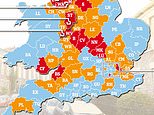Talk of nuclear war has once again ramped up since outgoing US president Joe Biden approved Ukraine to fire American-made missiles deep into Russia.
If Vladimir Putin were to follow through on his threats, the below map shows the states most and least at risk of a nuclear attack.
The Midwest would be a prime target because it houses the country's intercontinental ballistic missile (ICBM) launch facilities and taking them out early would be a strategic advantage for any foreign adversary.
With this as their starting point, researchers at the University of Massachusetts Amherst mapped how wind patterns would have carried the fallout on each day alongside the amount of radiation exposure that would reach the rest of the US.
The researchers based their results on enemies targeting the 450 ballistic missile silos because detonating just two would have the equivalent explosion of 100,000 tons of TNT.
They found people living along the East Coast would be the least at risk of being hit due to the distance from the bomb site and nuclear fallout zone.
The safe zone range would extend from Maine to Florida and cover a few inland states including Indiana, Michigan and Alabama.
Those living on the West Coast would also be less affected by a nuclear fallout including Washington, Utah, California and parts of southern Texas.
However, the map only looked at the initial impact and it's estimated that the nuclear winter that would follow would kill at least one billion Americans.


Experts have expressed that 'nowhere is truly safe' if such an attack took place, adding that a nuclear attack on the silos would detonate one or two of America's own intercontinental missiles.
Christian Appy, the director of the Ellsberg Initiative for Peace and Democracy at the University of Massachusetts Amherst, told Newsweek that immediately after an attack, 'even a relatively 'small' nuclear war would cause a nuclear winter famine that would kill at least a billion people [worldwide].'
The exposure to radiation poisoning would also put another 300 million Americans at risk of death in the four days following a nuclear attack.
Even low levels of radiation poisoning can cause nausea, fatigue, vomiting, diarrhea, skin damage, seizures or comas.
Landlocked states like Nebraska, Kansas, Iowa and Missouri would be decimated in the immediate aftermath of the explosion.
Meanwhile coastal states like Oregon, Washington, Florida and New York might be able to bide their time for at least four days, before radiation poisoning spread to those areas.
The initial impact would put three million people living around the silos at risk of receiving eight grays (Gy) of radiation in the four days following the attack, resulting in certain death - one Gy is enough to cause radiation sickness.
However, because of their distance from the epicenter, people living in some East Coast states like Florida and southern Georgia would be hit with as low as .001 Gy's of radiation.


The annual public limit is .001, while .05 is the annual limit for radiation workers.
This is still enough to cause health issues and possible death, but the reduced amount of radiation would put residents living in those areas at a significantly lower risk.
At high enough doses of penetrating radiation, these symptoms can start within minutes and can be deadly.
The map showed anyone living in the Midwest would likely be immediately killed, with Montana, North and South Dakota, Nebraska and parts of Colorado, Wyoming and Kansas being the hardest hit.
Although the population density in those states are low compared to other neighboring states, the winds could carry the radioactive material across the entirety of the US.
Appy told Newsweek that is is 'morally repugnant to think about the safest places to survive a nuclear war' because 'a major nuclear war would throw so much soot and debris into the stratosphere that it would produce a nuclear winter that would kill all or nearly all of those who survived the blast, firestorms, and radiation of the war.'
Using weather patterns recorded through 2021, scientists simulated the aftereffects of an 800-kiloton warhead hitting every one of the 450 silos at once to cripple the US arsenal.
'They thereby averaged the impact of shifting winds on radioactive fallout across the continent,' according to a report by Scientific American.
The warning comes as Russian President Vladimir Putin signed a decree last month that updated the country's policy on using nuclear weapons.
The revised doctrine asserts that Russia 'reserves the right' to use nuclear weapons to not only respond to a nuclear attack from another country, but also in response to a 'critical threat' to its 'sovereignty and territorial integrity.'
The Kremlin initiated the doctrine revision after President Joe Biden authorized Ukraine to use US-supplied long-range missiles as the war between the two countries hit 1,000 days.
The US Department of Defense told DailyMail.com it was unable to comment on nuclear projections or the likelihood of a Russian attack on US soil.












